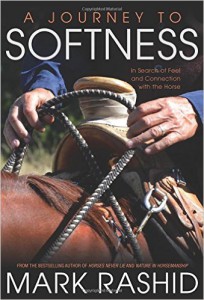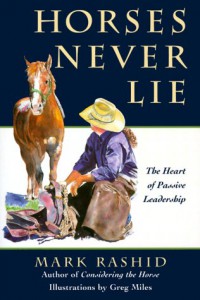Mark Rashid has an unique style to his writing. His words of equine wisdom are delivered in the story telling style that takes me to sitting around a campfire and listing to the words of a gifted horseman. Leaving you with a you with a description that fills the mind with awareness.
Mark began working with horses at age ten, when he met the ‘old man’, who taught him to work with horses, not against them, and to listen to what the horse is trying to say. As you read through the collection of beautifully written stories you get a look into the life that produced a man known for his ability to solve training issues with communication rather then force.
EXCERPT FROM “A JOURNEY TO SOFTNESS”, Mark’s book, from the Book/DVD package of the same name.
I recall one time when I was about eleven, I was riding a little gelding named Spark and was having trouble getting him to turn and stop. If I pulled to the right, he would pull to the left, if I pulled to the left, he would pull to the right. If I pulled on him to try to get a stop, he would push into my hands and just keep walking forward. The longer I rode him, the more frustrated I got, and the more he seemed to want to fight with me.
Now keep in mind that everybody, both humans and horses and regardless of age, are always working to the level of their knowledge base and life experience. This was certainly my case while working with Spark. At the time, I hadn’t ridden very many horses and so my knowledge base was limited to things that I had ridden, such as a bicycle. With a bicycle, when you turn the handlebars to the left, the thing goes to the left. When you turn them to the right, it goes to the right and when you stop pedaling, the thing stops. I guess I just naturally assumed that a horse would operate the same way.
It’s the way an eleven year old thinks. Until he knows better, a horse and a bicycle are basically the same thing because intellectually there is a gap in his mind between the bicycle being a “machine” and always doing what it is told, when it is told, and horse being a living, breathing, thinking animal with ideas, feelings and emotions. Because of this gap, in the child’s mind, both things should operate basically the same way. If you turn to the right, they should both go right, and so on. That is why a child with a limited knowledge base will become frustrated pretty quickly when a horse begins to express its feelings, ideas and emotions when being ridden.
At any rate, the old man had been standing and watching me for a while as I struggled to do just about anything with Spark, when I guess he couldn’t stand it anymore. He finally walked up. The gelding and I had just finished a monumental battle, which started out in the front pasture and ended some hundred yards away up by the hay barn. I had tried getting Spark to turn one way, then the other, and finally when both of those failed, I tried to get him to stop. That failed too. That is, right up until he drug the two of us unceremoniously over to that big hay barn, put his nose on the faded yellow brick wall, and then just stood there.
“Horses don’t like to be pulled on.” The old man said, drily as he walked up and petting Spark on the neck.
“I wasn’t pulling on him, he was pulling on me!” I argued as only and eleven year old could. “Every time I try to make him do anything he just wants to do something else. He doesn’t want to turn, he doesn’t want to stop, he doesn’t want to…”
The old man held up his thick fingered and well weathered calloused hand, signaling me to stop talking, which I did. Even at eleven years old, I knew better than to talk into a hand that looked like that. He reached down and with two fingers picked up the left rein, the one that was closest to him. Then, by lifting the rein but using hardly any contact when he did, Spark began to easily turn his head to the left. He gently lowered the rein, then reached across Spark’s neck and took a gentle hold on the right rein. He repeated the same action with that rein, and Spark responded by effortlessly turning his head to the right. He lowered that rein, allowing Spark’s head to straighten, then, while still holding the right rein, he took a gentle hold on the left rein with his left hand and again, taking up gentle and minimal contact on both reins, Spark began to willingly back up.
He backed Spark away from the wall seven or eight feet, then let go of the right rein. Still holding the left rein, he led the two of us back out into the pasture where all of the trouble began in the first place.
“Horses don’t like to be pulled on.” He repeated. Then he turned Spark and I loose and walked away.
 Mark is the author of several books – Considering the Horse; A Good Horse is Never a Bad Color; Horses Never Lie; Life Lessons from a Ranch Horse; Horsemanship Through Life; Big Horses, Good Dogs & Straight Fences; A Life With Horses; Whole Heart, Whole Horse; and, Out of the Wild. No matter your level of riding, age or discipline you will enjoy the connection that he is able to share with you.
Mark is the author of several books – Considering the Horse; A Good Horse is Never a Bad Color; Horses Never Lie; Life Lessons from a Ranch Horse; Horsemanship Through Life; Big Horses, Good Dogs & Straight Fences; A Life With Horses; Whole Heart, Whole Horse; and, Out of the Wild. No matter your level of riding, age or discipline you will enjoy the connection that he is able to share with you.
To find out more about Mark Rashid go to www.markrashid.com, on Facebook at Considering the Horse, Mark Rashid. Interested in learning more about his books check out Amazon.com and order yours today!


